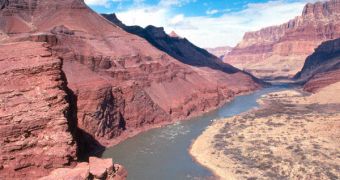Investigators have determined that a body of water similar in size to the modern-day Colorado River may have flow backwards, from California to Arizona and Utah.
The study reveals that the ancient California River would have appeared to be flowing backwards for modern observers trekking along its shore, or rafting on its water.
The new name was given to it because California is where it is thought to have originated. The team that discovered the water was led by experts based at the Carnegie Institution of Washington, in Washington DC.
The group, which was led by Carnegie post-doctoral researcher Steven Davis, made the impressive finding by comparing sedimentary deposits they identified in Utah and Arizona.
They compared uranium and lead atoms and isotopes, and determined that the sand which areas in both states had had not been produced there. The sand grains were made out of the mineral zircon.
Much to their amazement, the researchers determined that the sand had originated from igneous bedrocks in the Mojave region of southern California, Our Amazing Planet reports.
The ancient river ended in a delta, as indicated by deposits made in Utah, which are known among geologists as the Colton Formation.
In this area, experts say, the California River emptied into a large lake, that has since disappeared. The length of the former body of water was calculated to be 400 miles (700 kilometers).
“The river was on a very similar scale to the modern Colorado-Green River system," Davis said, "but it flowed in the opposite direction,” Davis explains.
He goes on to say that the new investigation found no evidence that it was this river which began eroding the Grand Canyon. The California River flowed some 55 million years ago.
Many researchers have proposed that the giant canyon system was carved by other rivers as well, before the Colorado began grinding at it some 20 million years ago. But Davis found no evidence to support this.
“The Grand Canyon would have been on the river's route as it flowed from the Mojave to Utah,” the expert explains.
“It stands to reason that if there was major erosion of a canyon going on we would see lots of zircon grains from that area, but we don't,” he goes on to say.
Davis believes that the California River stopped flowing when the Rocky Mountains began forming.
“The river could have persisted for as long as 20 million years before the topography shifted enough to reverse its flow,” Davis concludes.

 14 DAY TRIAL //
14 DAY TRIAL //